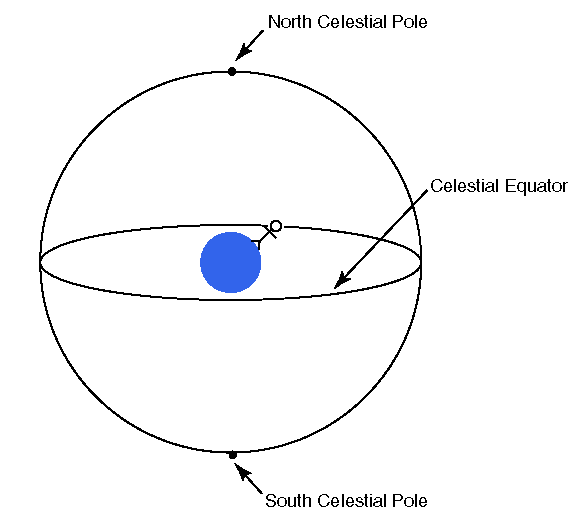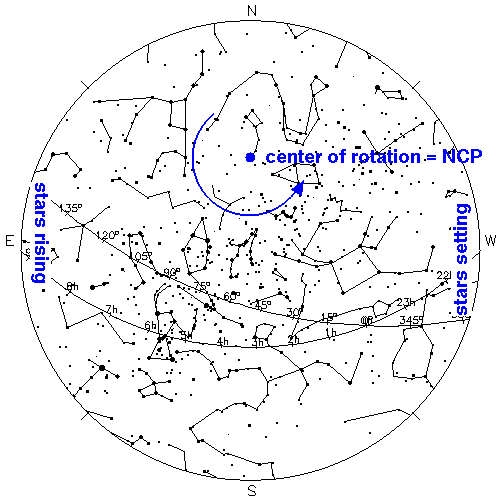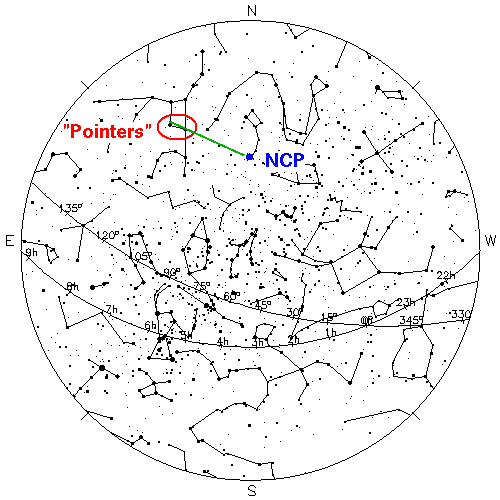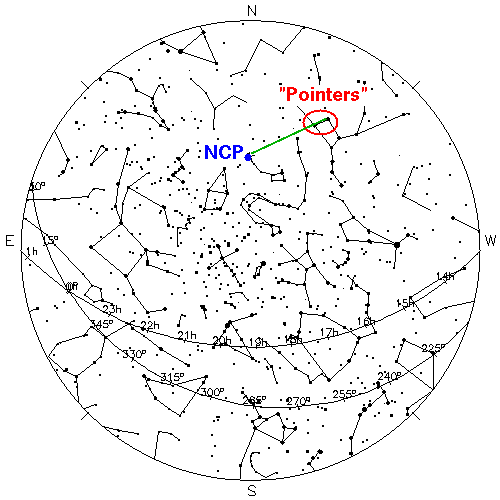


The whole celestial sphere seems to rotate about an axis through its center. We see this axis as two centers of rotation (and hence fixed points) in the sky: the north celestial pole (NCP) and the south celestial pole (SCP). (The south celestial pole is diametrically opposite the NCP, and hence visible only in the southern hemisphere of the Earth.) Of course really the sky is not rotating; rather the Earth is rotating. The apparent rotation centers in the sky are just the projection of the Earth's rotation axis into the sky.
Exactly between these two centers of rotation we sketch the imaginary line of the celestial sphere's equator. The celestial equator is just the projection of the Earth's equator into the sky.

In the above figure we have oriented the celestial sphere so the north celestial pole is up. At the center of the celestial sphere is the blue ball of Earth with the stick figure standing straight up in Minnesota. Note that the celestial poles are extensions of the Earth's poles, and the celestial equator can be found by expanding out the Earth's equator.
Because of this apparent rotation of the sky, stars seem to rise in the east and set in the west. Meanwhile the stars near the NCP just make big circles about the NCP.

Notice in the above diagram that the celestial equator exactly meets the due east and due west points on the horizon.
If you face north, the stars seem to move counter clockwise around the NCP (which is near the star Polaris in the Little Dipper). Towards are right (east) stars are rising; towards our left (west) stars are setting. The best way to understand this motion is to watch this movie (QT=6.7Mb, if your browser doesn't understand QT try WEBm ). Each frame is 10 minutes of real time.
If we face east, the stars will be rising. Facing east, we find north on our left and south on our right. The stars take an upward course moving also to the right. The celestial equator always connects with the due east point. The best way to understand this motion is to watch this movie (QT=7.8Mb, if your browser doesn't understand QT try WEBm).
If we face west, the stars will be setting. Facing west, we find north on our right and south on our left. The stars take a downward course moving also to the right. The celestial equator always connects with the due west point. The best way to understand this motion is to watch this movie (QT=7.8Mb, if your browser doesn't understand QT try WEBm).
If we face south, the stars will be moving to the right. Facing south, we find east on our right and west on our left. The best way to understand this motion is to watch this movie (QT=7.8Mb, if your browser doesn't understand QT try WEBm).
This
movie (QT=13.6Mb, if your browser doesn't understand QT try
WEBm) shows the whole
sky map turn with time.
Finding the NCP
In the northern hemisphere, the NCP is relatively easy to find in the
sky, as it is near (within 1°) a relatively bright (magnitude=2)
star: Polaris (a.k.a.  -UMi or HR424).
Polaris is at the far end of the handle of the "Little Dipper" in the
constellation Ursa Minor. To make things even easier, the "Big Dipper"
(part of the constellation Ursa Major) can be used to find the "Little
Dipper". The two stars that form the lip of the bowl of the "Big Dipper" --
known as the "Pointers" -- point the way to Polaris:
If you follow the line (green in the below figures)
made by connecting the two Pointer stars, you will run into the
"Little Dipper" and its brightest star Polaris. (Polaris is about
30°, or two hand-spans, away from the top pointer star.) Since the stars
have constant relative positions, this method works any time you
can see the Pointers. Of course, once you've found the NCP,
you've also found the direction true north. Here are a couple of examples:
-UMi or HR424).
Polaris is at the far end of the handle of the "Little Dipper" in the
constellation Ursa Minor. To make things even easier, the "Big Dipper"
(part of the constellation Ursa Major) can be used to find the "Little
Dipper". The two stars that form the lip of the bowl of the "Big Dipper" --
known as the "Pointers" -- point the way to Polaris:
If you follow the line (green in the below figures)
made by connecting the two Pointer stars, you will run into the
"Little Dipper" and its brightest star Polaris. (Polaris is about
30°, or two hand-spans, away from the top pointer star.) Since the stars
have constant relative positions, this method works any time you
can see the Pointers. Of course, once you've found the NCP,
you've also found the direction true north. Here are a couple of examples:


If you return to the looking-north movie (QT=6.7Mb, if your browser doesn't understand QT try WEBm), you'll see that as the sky rotates, the pointer stars continually point at the NCP.
Note that there are no particularly bright stars near the SCP.